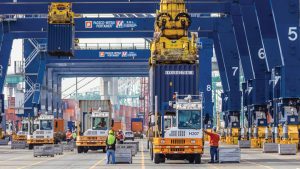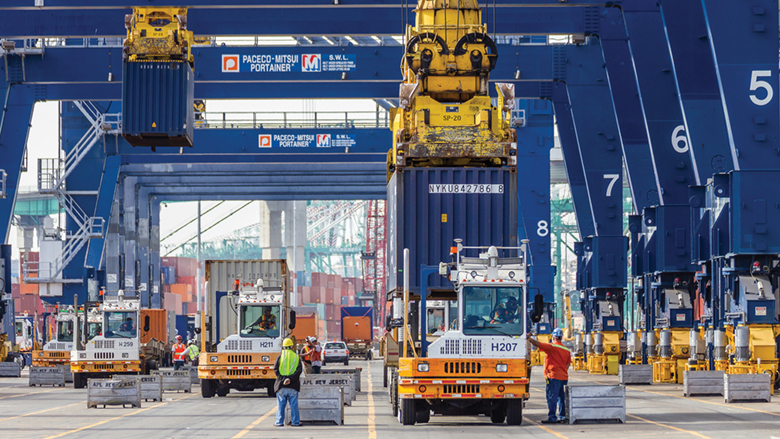Cargo handling bridges the divide between tradition and technological innovation as aging equipment is updated and new options are being added.

Much of the time, the focus of maritime industry headlines is ships, which can leave equipment and logistics as an afterthought. Yet these machines and the technology used within them make up a vital part of the maritime shipping process—container-handling equipment or cargo-handling equipment (CHE).
CHE generally consists of the equipment used to move, load, and unload cargo and containers between ships and the dock. As described in the reference Ship Construction (7th Edition), this equipment went largely unchanged for decades, until the 1960s began to bring about awareness of loss due to inefficiencies and gains through upgrades and improvement. First came the development of retractable and rolling-steel hatch covers, as well as shipborne cranes that began to replace rigged derrick forms and winch systems.
Our modern understanding of containers and cargo handling is again experiencing dramatic innovation that can help improve operations and efficiency. Modern cargo handling currently bridges the divide between tradition and technological innovation as aging equipment is updated and new options are being added for ports and ships across the world.
The Importance of Updates and Upgrades
Modernizing CHE is not simply about having a smoother load and unload experience, although that should be a benefit. The U.S. Environmental Protection Agency (EPA) makes it clear that better CHE both optimizes load and unload times, as well as reduces environmental impact.
Based on 2004 EPA standards, the reduction of machinery powered by inefficient diesel engines is key. To create the best return on investment, the agency suggests beginning upgrades with machinery that “should have operated at least 1,000 hours per year for the past two years and have at least three years of remaining life” to maximize the benefit and maintain eligibility for the Diesel Emissions Reduction Act (DERA) funding program. For machinery that is not ready for a full upgrade, retrofitting engines is an additional recommendation.
Cloud-Based Container Management
Port Optimizer is a cloud-based technology created by Wabtec. The system is described as a first-of-its-kind software designed to digitize maritime shipping data for port officials, cargo owners and other stakeholders in the supply chain. The technology, which was deployed in 2017 at the Port of Los Angeles, continues to provide live information today.
“Port Optimizer gives our supply chain community a holistic view of what’s happening—well in advance,” Port of LA Executive Director Gene Seroka said. “It is enabling a new level of efficiency and optimization.”
Data sources tracked by the software include shipping lines and marine terminals as well as third-party data. Benefits include around 14-day advance visibility allowing reduced cargo inspection and dynamic ETAs as machine learning algorithms improve predictability. When deployed, port productivity is predicted to increase by 8-12%.
Electric Power Adds Force to Lifting Trucks
The Northwest Seaport Alliance in Tacoma Harbor began increasing the use of electric lift loading trucks in 2021.
“The NWSA is thrilled to build upon the work of the Northwest Ports Clean Air Strategy and welcome this new zero-emission technology to our Tacoma Harbor,” Dick Marzano, Port of Tacoma Commission President and Managing Member of the NWSA, said. “This is just the beginning of showing the longstanding operational and environmental benefits of electric yard trucks within our gateway.”
A total of six new yard trucks are being funded with the support of a DERA grant to the Seaport Alliance that includes $130,000 for Tacoma Power’s Cargo/Material Handler Equipment incentive. The trucks are expected to reduce emissions by 260 tons annually while being less expensive to operate due to reduced maintenance costs.
In February, the port welcomed its first new zero-emission, electric-yard truck at a time when monthly imports reached an all-time high.
Automated Container Cranes
Smart technology cranes are making headlines, specifically the Konecranes Rail-Mounted Gantry (RMG). Terminal Graneles del Norte (TGN) in Chile in 2023 is expected to launch what is described as a “world-first in automated RMG operation” for intermodal cargo operation.
Alfredo Ramirez, regional sales manager for the Americas, for Konecranes, explains “These RMG cranes will work in a special intermodal operation serving trucks and trains arriving from one of the largest copper mines in the world. They will handle special containers that carry copper concentrate—offloading full containers from trains and trucks, and loading them with empty containers.”
The system’s container stacking are designed to be automated, while a human would remotely operate lift and land onto wagons. Safety is to be managed through proprietary technology including Gantry Collision Prevention, Auto-truck Guiding and Truck Lift Prevention.
AI Modeling
Technology leaders Aidrivers Ltd. and supply chain and infrastructure firm Jacobs entered an agreement in February, embracing artificial technology in shipping. Some industries regard AI as disruptive, but in this case, the advances may actually prevent global interruptions of shipping and distribution.
“The global ports and logistics sector is facing unprecedented challenges at present, in terms of congestion, delays, and supply-chain disruption,” Dr Rafiq Swash, CEO of Aidrivers told the journal Port Technology International. “Putting AI and autonomy at the center of design at the earliest stages is crucial to creating the efficient, cost-effective, sustainable transport solutions and streamlined operations we need for the future.
Aidrivers is known for autonomous technology, such as fleet operators and tow tractors, but perhaps of special interest is the company’s proprietary 3D simulation-based Digital Twin solution.
This modeling software allows a terminal to eliminate downtime and costly changes by deploying or redeploying equipment in a virtual environment first. Instead of onboarding a new electric vehicle in real time, for example, the company could first test the changes in the 3D simulation.
Aldo Ferrufino of Aidrivers calls the technology a “digital twin” and “undisruptive optimization” that “is installed parallel to your operations,” while providing training, simulation and data reprocessing.
Microgrids Ensure Operability
The shift toward digital and electric solutions certainly sounds promising, but it what happens to these solutions in a power outage? The Port of Long Beach, in partnership with Schneider Electric is seeking to mitigate that risk in a plan developed in 2018.
“Recent supply chain challenges underscore the Port of Long Beach’s importance and the need to maintain their operation to keep goods—and the economy—moving,” Mark Feasel, Schneider Electric’s president of smart grid North America, said in Microgrid Knowledge.
Components of the new system include a 300-kW PV solar panel array and a 250-kW stationary battery energy storage system. The resulting facility is expected to not only reduce the port’s reliance on external power, but reduce the port’s electric costs by $60,000 annually.
“Adding a microgrid will enhance their critical energy resilience for greater reliability and business continuity, while increasing operational safety and environmental sustainability,” Feasel said. “This distributed power source offers energy security to maintain their operation and more predictable energy costs to support their bottom line.”
Construction of the $12.2 million microgrid project began in March 2022, according to the Port of Los Angeles.
The Future is Now
While the discussion of new technology in cargo handling and management seems futuristic, the reality is that rollout already has begun. Autonomous loaders and real-time digital cargo management aren’t science fiction, but are poised to disrupt and reposition our modern supply chain.
And ports across the Pacific and around the world are already obtaining and utilizing new digital and electric equipment with support from significant partnerships and allied organizations.

